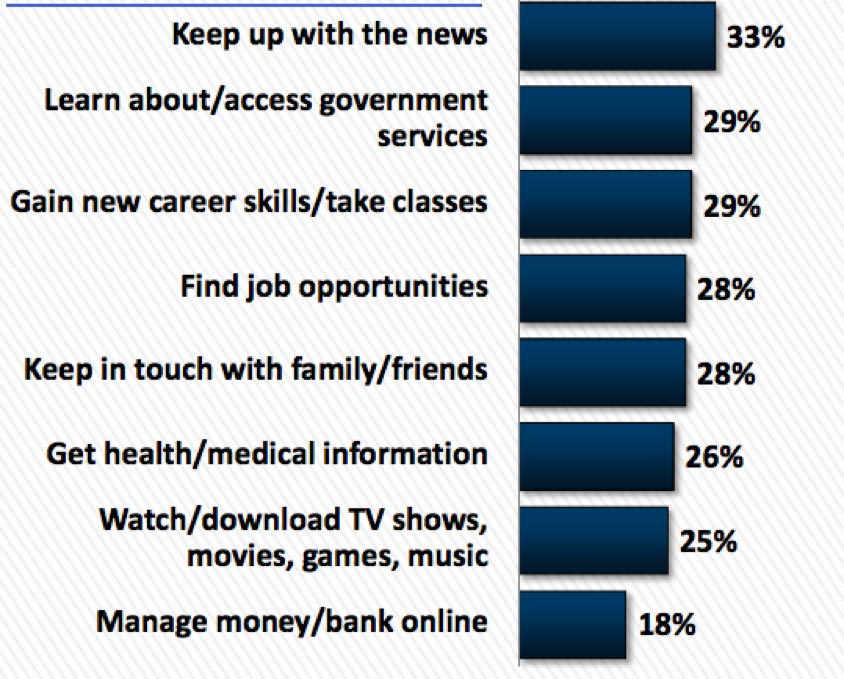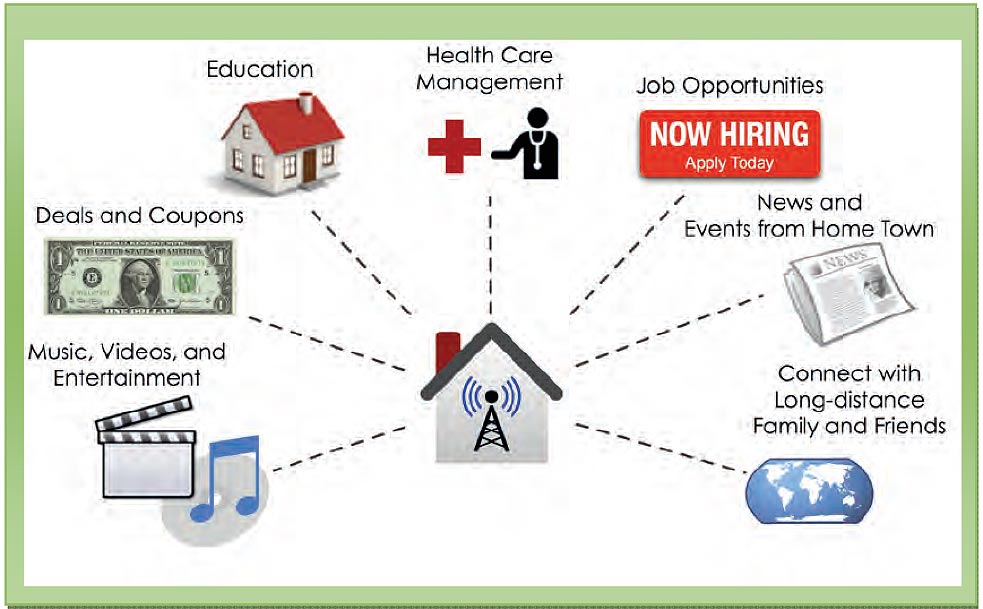Broadband access is critical to community prosperity, but less than half of California’s rural population has the same Internet access as urban areas.
Broadband for Better Communities
Broadband for Better Communities
In the 21st century, high-speed Internet access is no longer a luxury amenity, but rather an essential service for homes and businesses in this interconnected world. No other technology has produced as much innovation, competition and economic growth.
Congressional letter to the new Administration, January 30, 2017

In today’s economy, broadband access is as critical to a community’s prosperity as it is to a company’s bottom-line. That access, however, is not fully developed nor equally available.
Residents in rural areas, for example, are less likely than their urban counterparts to have access to a wide variety of Internet-access devices and online services and functions, according to a 2016 report on “The State of the Urban/Rural Digital Divide” by the National Telecommunications and Information Administration.
Even in tech-pioneering California, the digital divide persists for both rural communities and low-income neighborhoods. Less than half (47%) of the state’s rural population has the same Internet access as urban areas, according to a California Public Utilities Commission report, and the state is not on track to meet its goal of 98% broadband access by 2017.
More than 618,800 households were estimated to be unserved or underserved (connected to the Internet at home only with a smartphone) statewide. Accessing the Internet only through a smartphone makes it more difficult for a student to do homework or an adult to acquire workforce skills or apply for a job. These “underconnected” residents don’t have access to the full range of digital technologies and therefore fewer opportunities to benefit from California’s economic prosperity.

In California, the groups most likely to have home broadband connectivity only through smartphones are adults who have not graduated from high school (29%), households whose total annual income is less than $22,000 (25%), Latinos (24%), Spanish-speaking households (30%) and households whose annual income is less than $40,000 (19%), according to the 2016 annual digital divide survey by the Field Poll.


Broadband infrastructure is greatly needed to improve access, speed and reliability for businesses and communities. It also helps farmers to adopt the innovative technologies transforming the food and agricultural industry. For all Californians, it can provide better access to e-health, distance learning, e-commerce, and public safety and other services.
Economic and environmental benefits
Critical to all aspects of California’s future, investments in broadband infrastructure and digital-access initiatives are fundamental to sustainable economic growth and global competitiveness.
Research indicates communities that improve their broadband service increase their jobs base and the number of businesses, generating hundreds of thousands of new jobs and billions of dollars for the California economy.
While better broadband access benefits all communities, it is especially critical for a changing agricultural economy.
California has the nation’s largest agricultural economy, totaling more than $47 billion, and ranks 9th globally when compared against entire nations. In 2011, the California Community Colleges estimated that the entire value chain of the food and agriculture cluster – which encompasses production, processing and packaging, distribution and support services – accounted for almost 2.5 million jobs.
Broadband infrastructure allows farmers to use water, fertilizer and fuel use more efficiently through remote sensing and monitoring technologies. The result is increased yields, better monitoring for food safety and security, and expanded access to market and distribution networks. Emerging agriculture and production-driven technologies depend on the wireless transmission of data for economic growth and sustainability.
Expanding broadband access is also good for public health and the environment, with modern approaches to e-government, telehealth, telecommuting, smart buildings and smart grids that help California communities reduce its carbon footprint.

Strategies for improving broadband access
Closing the digital divide will require much greater investment from local, state and federal partners to support private-public partnerships, streamline permitting requirements for broadband infrastructure, provide rights-of-way for broadband providers, and develop “dig once” policies for broadband infrastructure that can reduce costs and environmental impacts.
The California Emerging Technology Fund’s “Getting Connected for Economic Prosperity and Quality of Life: A Resource Guide for Local and Regional Government Leaders to Promote Broadband Deployment and Adoption” highlights a number of steps that communities can take to increase broadband access by upgrading existing infrastructure and investing in next-generation technologies:
Land Use and Smart Infrastructure
- Provide broadband infrastructure in all public buildings and other infrastructure projects.
- Require new or renovated residential and commercial development projects to provide broadband connectivity. Require broadband connectivity and periodic upgrades in conditional use permits.
- Identify local public rights-of-way and public facilities for broadband and streamline the approval of easement encroachment permits.
- Submit notification and information about all major infrastructure and construction projects to a shared web-based database (such as the prototype developed by Caltrans) so that broadband and other utility providers can coordinate infrastructure in shared trenches, conduit, poles and towers to reduce costs, save time, and minimize duplicative construction.
Telecommuting
- Develop an employee program to foster telecommuting.
- Encourage and assist local employers to develop and offer telecommuting to reduce traffic congestion and environmental impacts.
Public Services and Digital Inclusion
- Prepare and implement a Technology Plan that uses state-of-art broadband so that local governments can operate in the most cost-efficient manner possible. Provide all vital public information and critical services online.
- Promote the use of public buildings – libraries, parks and meeting centers – as broadband hot spots to give residents affordable (or free) high-speed Internet access.
Smart Housing
- Require all new residential subdivisions to be served with state-of-art broadband infrastructure with sufficient transmission rates.
- Require all publicly subsidized housing development to provide an independent and more affordable “advanced communications network” – aggregating high-speed Internet access service throughout the property rather than unit-by-unit – to significantly reduce the cost of Internet access for lower-income residents.
- Establish housing-authority policies that promote and support smart, affordable housing with advanced communications networks whenever public funds are used to subsidize the construction of affordable housing.
Digital Literacy and Workforce Development
- Integrate digital-literacy training into all workforce development programs.
- Provide digital literacy (combined with computer/Internet skills upgrades) training for all employees.

Designation of Broadband Leader
- Direct the chief executive officer to designate a management-level coordinator to be responsible for implementing broadband, information technologies and digital-inclusion policies.
Interagency Cooperation
- Outline a process for ensuring inter-agency and inter-jurisdictional cooperation: share this policy with other jurisdictions in the region; meet to explore common needs for infrastructure; identify opportunities to collaborate on broadband applications (such as telemedicine) or regional projects, such as library networks; and notify neighboring jurisdictions about major infrastructure projects, such as transportation improvements along shared corridors.
- Work with other public and private entities – schools, special districts, utilities, and private health and medical providers – to cooperate and joint-venture on broadband projects and programs.
On the path to equal access for equitable communities
Ensuring that all residents have high-quality Internet access is a matter of social equity. Expanding broadband into underserved and unserved homes, schools and businesses will help close gaps in access to digital technologies as well as gaps in access to other basics like healthy foods, transportation, quality healthcare, good jobs and banking services. Today, education – a critical step toward individual and community prosperity – requires basic digital literacy and access to technology tools. It is imperative in all these aspects of our resident’s lives that we provide equal access to 21st-century pathways for success.
Resources
- California Emerging Technology Fund, “Getting Connected for Economic Prosperity and Quality of Life: A Resource Guide for Local and Regional Government Leaders to Promote Broadband Deployment and Adoption”
- California Emerging Technology Fund, “Lessons Learned from the Field: Connecting Californians to Broadband and Digital Careers”
- National Telecommunications and Information Administration, “Broadband Adoption Toolkit”
- Valley Vision, “Broadband as a Green Strategy”
Local Government Commission Newsletters
Livable Places Update
CURRENTS Newsletter
CivicSpark™ Newsletter
LGC Newsletters
Keep up to date with LGC’s newsletters!
Livable Places Update – April
April’s article: Microtransit: Right-Sizing Transportation to Improve Community Mobility
Currents: Spring 2019
Currents provides readers with current information on energy issues affecting local governments in California.
CivicSpark Newsletter – March
This monthly CivicSpark newsletter features updates on CivicSpark projects and highlights.



